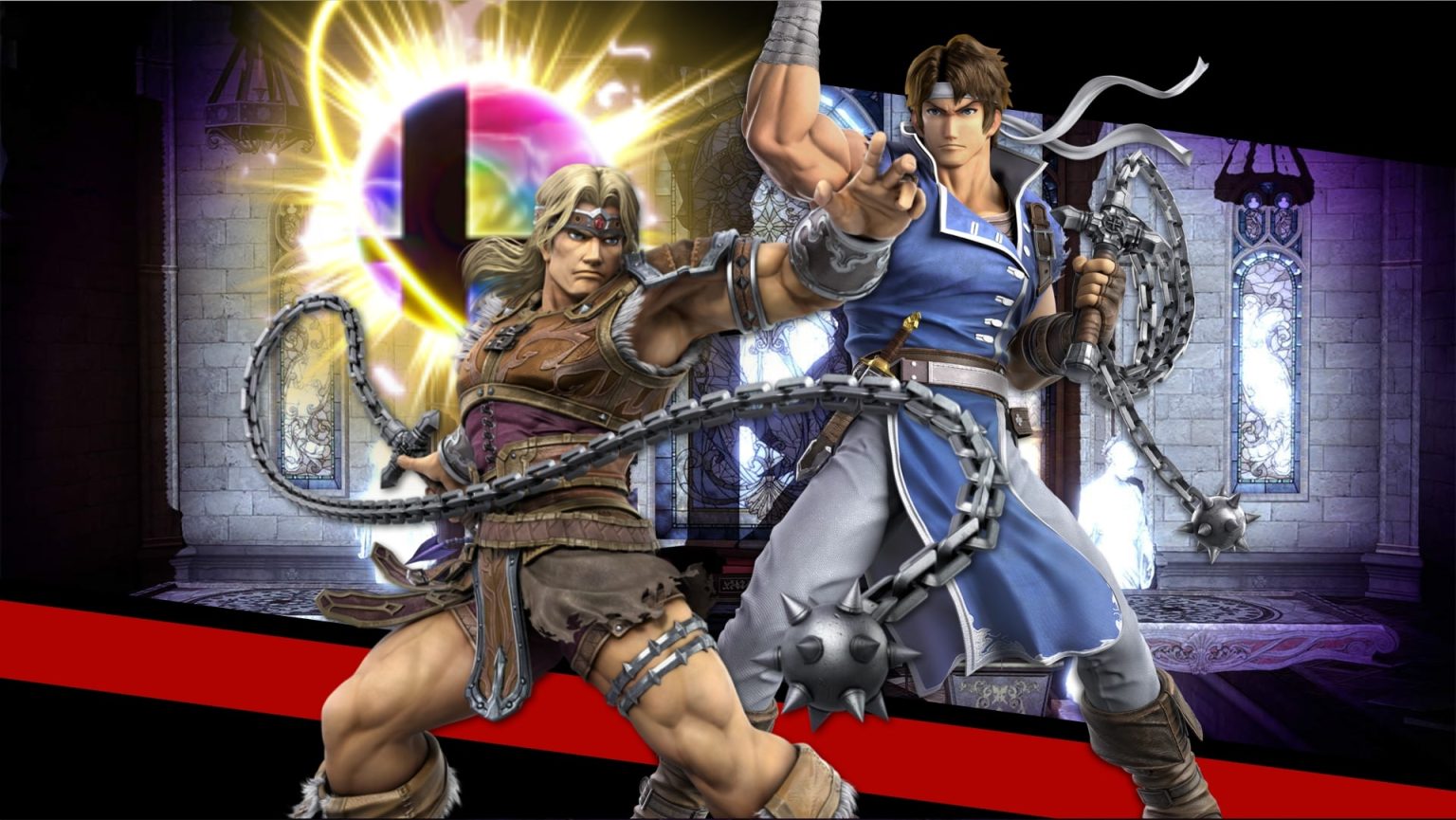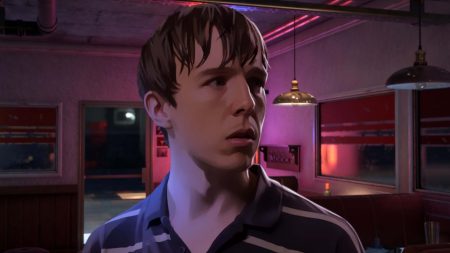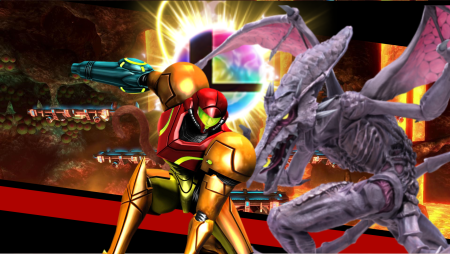Everyone Is Here
I’ve always believed the strength of a fighting game’s roster helps to define it’s longevity. It’s one of the reasons the Super Smash Bros. franchise is so infinitely replayable. For Super Smash Bros. Ultimate, which is just around the corner, the sheer number of Nintendo’s most beloved characters crammed into one package is simply astounding.
We all know and love them. There’s that one crocodile with a crown from the monkey games. Then there’s the small boy with psychic powers and the… other small boy with psychic powers. Oh, and you can’t forget Mario, Green Mario and everyone’s favorite Fart Mario. Finally, rounding off the roster, you’ve got anime boy with sword, anime boy with sword, anime boy with sword, anime boy with sword, and Cloud.
Yeah, I had a PlayStation growing up.
I have so much respect for what Smash Bros. is: a limitless nostalgia-fest packaged into one of the most enjoyable party/fighting games ever. Since playing Super Smash Bros. Brawl, I have spent a lot of time with every entry of the series before and after. I know the characters’ moves by heart, I’ve listened to their music, and I’ve played on their stages.
But I’ve never played their games.
The Challenge
There are some exceptions. I’ve always been a huge Pokémon fan for example, but for the most part I haven’t really played many Nintendo games. Of course, there are more obscure cult classic titles like Earthbound that a lot of people skipped over, but my gaps stretch a little further than that. I’ve never finished a Legend of Zelda title, I haven’t played any Metroid games, and I’m still not one-hundred percent sure what a Star Fox is.
And that’s all going to change. Starting this month, I am going to play through as many games as I can that feature Smash Bros. fighters until I’ve played at least one game for every character; then I’m going to review them. Including Echo Fighters and the five DLC characters yet to be announced, that’s a whopping eighty characters. It means I’m not going to run out of things to play any time soon!
The Rules
Before we really begin, I want to start by clarifying a few things up front. I don’t want to find the fastest route through the roster; rather, I want to take my time and experience as many different games as I can. For example, there are a lot of Super Mario characters in Smash, and so many of them feature in multiple games that I could probably strike off all nine Mario characters in one or two games.
Instead, I’ve done my research and picked a handful of games for each franchise, even multiple games for single characters where it interests me. This is going to be a trek through Nintendo’s history, not a sprint. Furthermore, when it comes to playing through The Legend of Zelda, it would be easy to ignore the three different Links that feature in Ultimate. I want to experience each character in a game that best represents them. I may not understand what differentiates Young Link, Toon Link, and plain old boring Link, but I want to.
Secondly, I’m going to be reviewing these games from a contemporary standpoint. I’ve watched a lot of people talk about nostalgic games in a nostalgic manner. Nintendo games are especially protected by rose-tinted goggles. There is no bubble for me. I want to know whether or not these games are worth revisiting or whether they deserve to be forgotten to the sands of time. We’ve all got those games that we rank a little higher than they deserve because we grew up with them, and that’s totally okay. Sometimes, little quirks that make older games unpleasant to play get a free pass because “that’s just how things were.” Nah, none of that. I’m going to be reviewing them as they stand.
Lastly, I’m not doing this in any real order, rather I’m just going to play these games as they fall into my lap. Video games aren’t cheap, and some of them take a lot of time. I’m trying to ignore the fact that there are multiple really long JRPGs on this list, but it’s a daunting challenge to say the least. I don’t want to have to lock myself into playing a game I don’t enjoy, simply because it’s the next game on the list.
A Journey Begins
With that out the way, let’s get this show on the road! When it comes to fighting games, I tend to lean towards two different kinds of characters. Firstly, I love a glass cannon, someone who embodies the Fighting game ethos of getting up close and personal. “Punish” them before they can punish you. There’s something nerve-wrackingly satisfying about the risk-reward gameplay that hooks me in. The second is a good projectile character. An unpopular pick, for sure, but I love the ducking and weaving you have to employ to keep perfect spacing between you and your opponent. Throw away, back up, and start hurling everything you have at them.
The Belmonts look like they may embody both of my favorite fighting styles. Simon and Richter Belmont originate from a time when Konami actually made games and weren’t literal pond scum. In 1986, the company created the first in a long line of Gothic platformers: Castlevania. While technically it was first released on the Famicom Disk System, the series is more fondly remembered for its NES and SNES releases, so these are what I tackled for the purpose of reviews.
The series revolves around the Belmont clan, a family of legendary monster hunters tasked with the duty of slaying Count Dracula. The series spans a number of Belmonts, but only Simon and Richter are getting the Smash treatment, so we’re focusing on them today. Both characters play near identically to one another in their respective games. Armed with the legendary whip Vampire Killer and a handful of handy items ranging from throwing daggers to vials of holy water, they are more than equipped to take on the hordes of shambling creatures inside the walls of Dracula’s castle.
Of all the newcomers not named Isabelle, the Belmonts are probably the two that I am most excited to play in Ultimate. Their whips provide a solid mix of strength and range, and their arsenal of items make for some fantastic combo potential. Packaged up as a pair of hot boys, and you’ve found my new favorite characters. It also provides me a pretty nice starting point for this challenge.
For many, the name Castlevania is most familiar with the sub-genre that it lends its name to: Metroidvania. I’ve dabbled in the Castlevania franchise some, but all of the entries that I’ve played have been Metroidvania-styled games—titles like Symphony of the Night and Dawn of Sorrow. When the series began, it was a much more linear affair, with a level-based format.
Castlevania
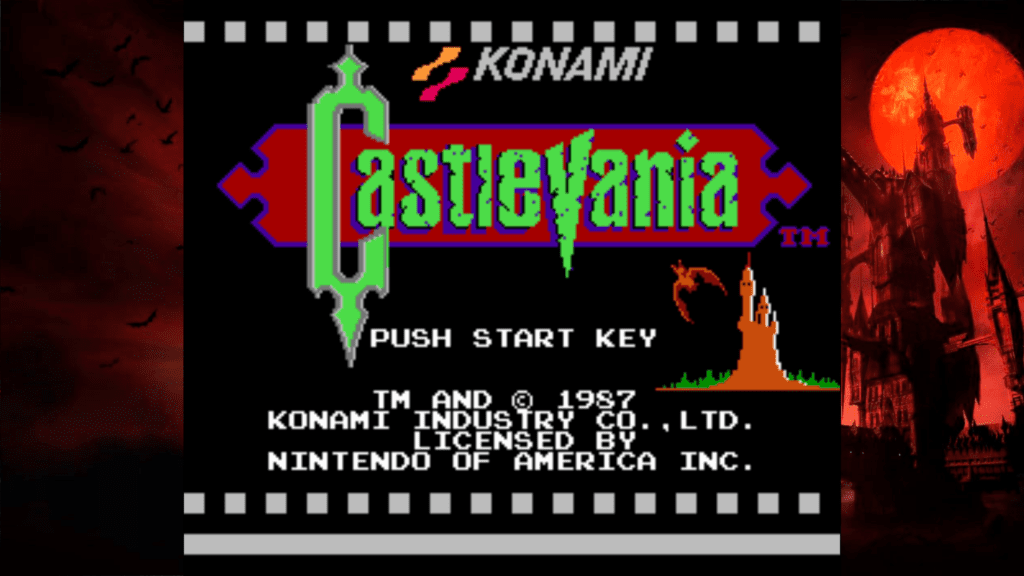
The first entry in the Castlevania franchise sees legendary vampire hunter Simon Belmont defending a small Transylvanian town from a newly resurrected Count Dracula. This simple bullet-point plot becomes a staple in the early Castlevania games and, honestly, it works. At no point in these early games does the plot take center stage. Technical limitations, especially in the NES era, often meant that story was limited to a few lines of opening scrawl or a couple lines of dialogue.
Instead, Castlevania takes a silent approach that winds up being really quite effective. The game starts with our protagonist outside the castle gates, the shadowy structure in the distance. Your quest needs no introduction: climb the spooky castle and conquer its master. There are a total of six stages, each concluding with a boss fight. The level design really helps capture this idea of exploring a dilapidated Gothic manor. Each area feels like a natural inclusion, ranging from the castle’s entry hall, to the catacombs below, to fighting your way across the ramparts. At the end of each stage, you are presented with a map of the castle, allowing you to track your path through Dracula’s abode. It’s a very simple story told in a very simple way, but I thought it was pretty effective.
The levels themselves are chock-full of ghoulish enemies, derived from classic horror films. There are basic minions like zombies, fish men, and living armor. Everything feels like a loving nod to the horror genre, but nothing more so than the boss fights. At the end of each stage, you square off against horror icons like Frankenstein and the Mummy. The game simply exudes a love for the creepy. The aesthetics of the game reflect the traditional Gothic tone to a tee, despite the graphical limitations. Everything is easily recognizable and helps to instantly place you into the world of Castlevania.
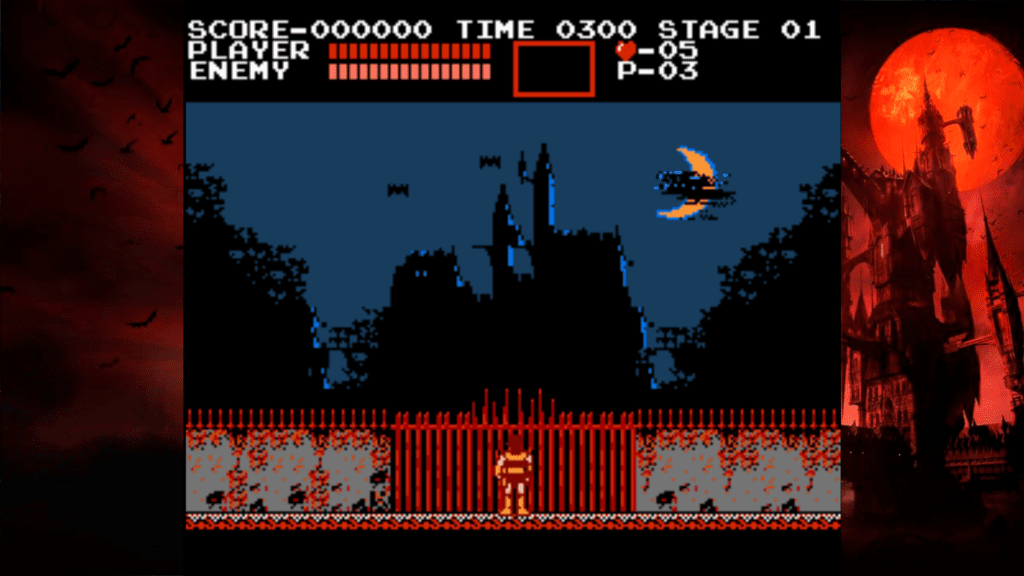
Now, the games of this generation have a certain reputation. Older cartridges had less storage space, which resulted in shorter games. With no real way to add any sort of replayability, the easiest way to artificially elongate a game was to make it hard. Castlevania is no exception. Each screen is an onslaught of enemies, projectiles, and pitfalls that require patience and wits to clear safely. Some screens just need a little bit of timing, holding out, and using your whip to block projectiles until you find your window to jump. Those sections feel great to nail.
Others… not so much. I don’t have much of a problem with “hard” games normally. If a game is truly difficult, then that simply presents itself as a challenge that can be overcome with time and practice. There are elements of that in Castlevania. Some of the bosses, like the Grim Reaper, simply took me a handful of tries until I nailed the pattern and figured out when to wail on the boss. Other sections have utterly unfair tactics designed to catch you off guard and take precious health away from you.
Everyone says it, but Medusa Heads are just the worst. They are constantly respawning enemies that float in from the sides of the screen, and are most prominent on screens with bountiful pitfalls. Mistime one jump and clip the corner of a Medusa’s hitbox and you’ll find yourself losing a precious life, plummeting to your untimely death. There’s no way to predict when and where one will spawn, which makes it hard to judge your jump time. These aren’t the only times where I felt like difficulty was tacked on: in fact, they’re not even the worst example for me.
No, that award goes to Frankenstein and Igor, the fourth boss of the game. The fight looks deceptively simple: there’s a lumbering giant enemy you whip in the head to deal damage, while a bouncy Hunchback hops around the screen, shooting fireballs at you. Dodge one, whip the other to win. Unfortunately, Igor has no real pattern to his movements, and reading the timing of his fireballs is incredibly frustrating. This one boss took me longer than any other in the game. It may not seem hard by my description and honestly, I may have simply missed something and made it harder for myself, but I just found this one fight to be all manners of randomized movements and difficult positioning.
Castlevania is satisfying to complete and a joy to play when it isn’t using cheap tactics to break the player. Tenacity is the name of the game. This game will beat you down, but if you can get back up and try again, then you’ll have a great time.
Graphics – 8/10
Music – 9/10
Gameplay – 6/10
Fun rating – 9/10
Overall, 8/10. It’s such a solid, fun game and it sets up a fantastic formula and world for the games that follow.
Simon’s story doesn’t end there; in fact, Richter doesn’t take over as the player character until 1993. Part of me considered skipping forward to his first game, but so much happens between the first Castlevania entry and Richter’s Rondo of Blood that I didn’t think it was fair to simply ignore so much of a franchise’s history.
Especially when there’s a black sheep in the family.
Castlevania II: Simon’s Quest
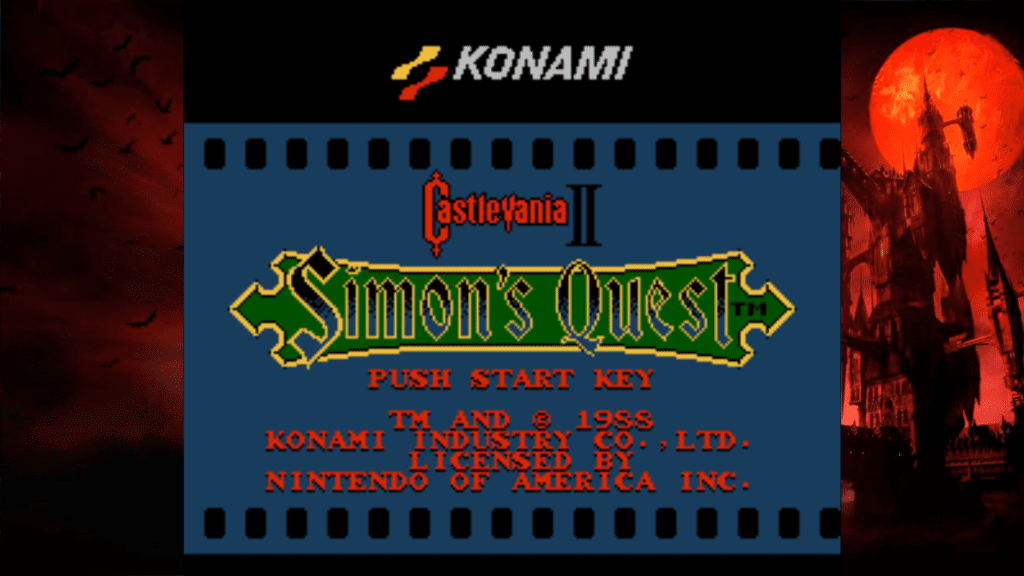
Castlevania II: Simon’s Quest is not a good game, but it is a formative one. Gone is the level format; instead, Simon’s Quest opens up Transylvania and lets you travel from town to town. There are five pieces of Count Dracula scattered across five manors. Collect all the body parts and take them to Dracula’s castle.
Now, here’s the first flaw of Simon’s Quest. Why? Why do I have to do… any of this? The formula of the original Castlevania is simple: Dracula comes back to life, and a Belmont has to go give him a good wallop to remind him that he’s been naughty. Dracula is still dead as of the start of this game and the game itself gives no real clues as to what is going on.
I hunted down a PDF of the original manual for the game. Turns out that after Simon killed Dracula in the first game, Dracula cursed him, and the only way to lift the curse is to destroy Dracula’s body. That makes sense, but it also hits on one of my biggest complaints of older NES/SNES games. If you’re going to add more story to your game, it needs to be in the game. Technical limitations exist, and I understand that, but there’s got to be some give and take. Simon’s Quest is filled with NPCs that spout lines of dialogue, often giving “hints” (we’ll get to that) about how to traverse the world. A few of those could easily be cut and replaced with a few opening cards that explain the game’s premise.
Castlevania’s story barely existed, but everything was shown to us, and things were kept simple to make sure that we understood the narrative despite the limitations of the NES. Simon’s Quest on the other hand tries to push the scope of its narrative, which ultimately, I respect, but the game itself fails to capture the story.
Change Isn’t Always Good.
In fact, everything that should be ‘more’ winds up hurting Simon’s Quest rather than helping. The open world is awful. The world consists of seven towns, five manors, and a series of linking forests, cemeteries, and caves. Nothing is really done to differentiate the areas, making them difficult to navigate. Most of the backdrops and elements are copy and pasted, with a different color palette if you’re lucky. None of the set pieces stood out, mainly because it didn’t feel like there were any. An open world is only interesting if there’s something to explore. I want to move to the next screen and be hit by a ‘wow’ factor, not just more of the same boring forests I was walking through during the first five minutes of the game.
I guess the Gothic charm is still present, but it feels lost without the setting. This might be a personal gripe, but the castle setting of the first one embodied the horror genre so well. Forests don’t really have the same dark undertones, and it just kills the vibe completely. It doesn’t feel like you’re progressing. Castlevania reminded you after every level that you were deeper and deeper into Dracula’s castle. After every milestone in Simon’s Quest, I was left underwhelmed and confused as to where I was meant to go next.
Confusion was definitely something I felt a lot of as I played. Of all this game’s shortcomings, the worst of all of them is how it plays. This game makes no sense; there is no logic involved in any element of the game’s design. Within half an hour of playing, I resorted to following a walkthrough. Normally I wouldn’t admit to that, but I have never played a game that needed one more. Manors are riddled with hidden passageways that you just have to luck upon by walking/jumping into every wall until you phase right through one. Even necessary-to-progress items are hidden in the towns. You have to walk around every room, throwing holy water at every surface until something just vanishes. There’s no rhyme or reason to it; it’s pure guesswork.
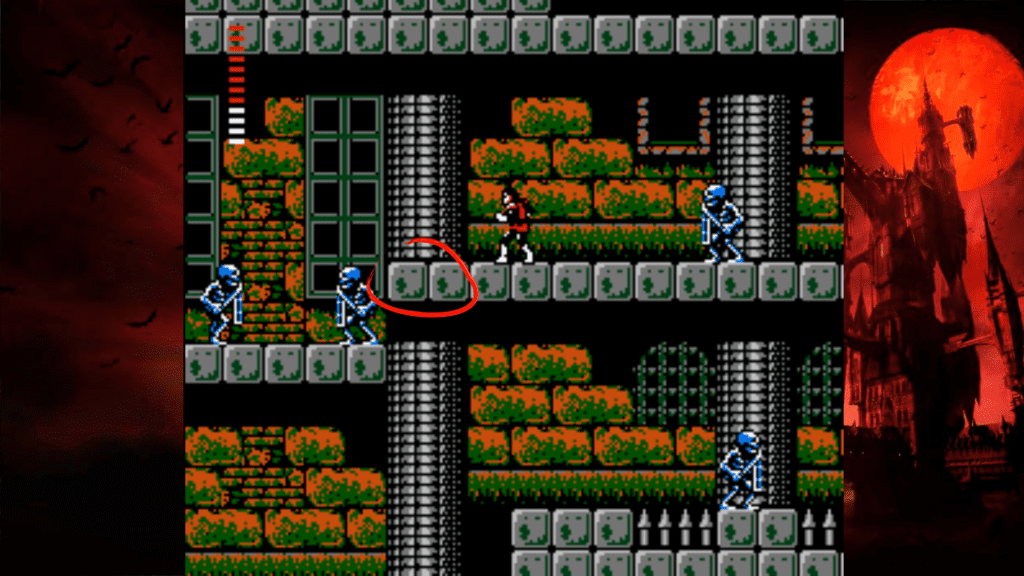
The NPCs in the game give you ‘hints.’ I tried to take note of what they said, but not one hint given wound up being useful. Everything they say is just cryptic nonsense. I read somewhere that it was due to bad localisation, but while it’s a reason, it doesn’t justify the mess that the game results in. To add insult to injury, all the dialogue in the game moves so slowly. Talking to anyone just wastes time, and the transition between the day and the night winds up taking too long and becoming a common frustration.
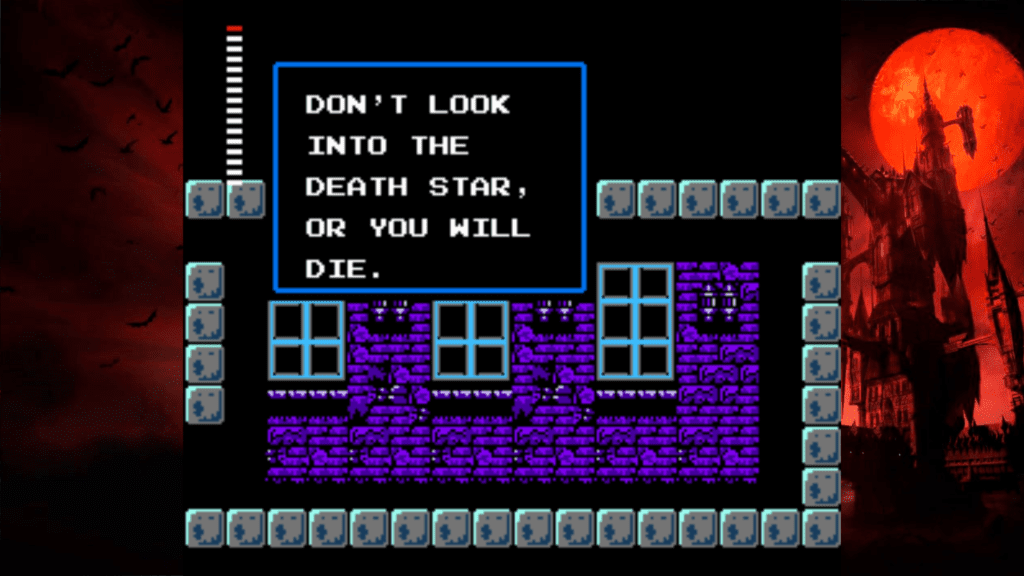
We’re still not done, because next on the list of bad things this bad game did is currency. Hearts are a Castlevania staple: normally they act as a resource allowing you to use your secondary items like the aforementioned holy water. Simon’s Quest, content on being the problem child of the franchise, decided that instead, you would use the hearts as money to buy items in towns. That would be fine if it didn’t result in utterly monotonous grinding. The only way to get hearts is to kill monsters, so you’ll often find yourself walking up and down one screen whipping the same skeletons over and over again until you’ve rounded up enough hearts to continue.
Finally, the last nail in this awful coffin: the game is really, really easy. Compared to its predecessor, there aren’t many unfair segments, which normally should be chalked up as a positive. It could also be because I followed a guide, but I mean that not even any of the game’s bosses (of which there was only a paltry three) caused me any trouble at all. There was no challenge, no fun, and no style.
Well, the music was still great.
Graphics – 5/10
Music – 9/10
Gameplay – 2/10
Fun rating – 1/10
Overall, 4.2/10, a score only hoisted up by the franchise’s killer soundtrack. Remember that amazing formula I mentioned before? Konami certainly didn’t here.
Now it’s finally time to put the NES and Simon to bed. Simon does star in one more game, Super Castlevania IV, (he was replaced by Trevor Belmont in III) before 1993 when Richter Belmont took the stage for the first time. His first appearance was in Castlevania: Rondo of Blood, a Japanese-only release that was then tweaked and published on the SNES for the rest of the world as Castlevania: Dracula X.
Castlevania: Dracula X
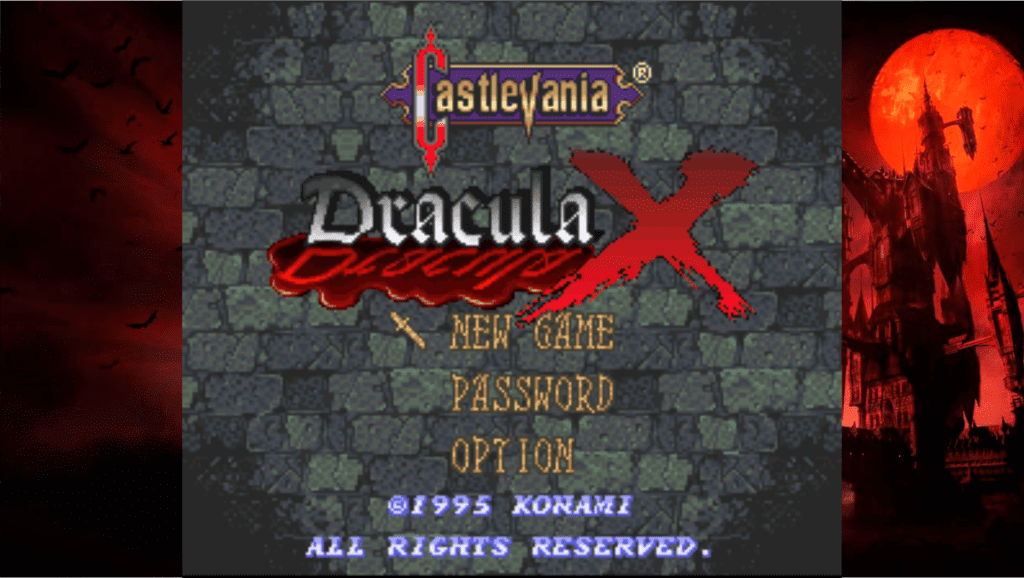
Set a few hundred years after the death of Simon, Dracula has decided nap time is over because some people had some mean thoughts. Apparently just having badness “in the hearts of men” is enough to bring cranky old Dracula and his castle full of monsters back to Transylvania. Seeking revenge against the Belmont clan, Dracula turns his attention to Richter. To lure Richter to his castle, he torches his town and kidnaps Richter’s lover and her sister.
And thus starts Dracula X. Instantly, it shows how much a little processing power can really enhance a game. Finally, my itch is scratched and the story of this entry is featured in the game. The game starts with a simple text scroll that explains Richter’s story and why Dracula has just popped back up after you’ve killed him multiple times. As an entry point, it’s easy to understand everything that’s going on and the game lets you leap right into the slaying.
This game has a really striking aesthetic that uses the extra bits of the SNES to both its advantage and disadvantage. Talking about the positives first, this game has some of the best spritework I’ve seen in ages; I’d even go as far to say that it’s probably the best looking SNES game I’ve ever played. Everything pops with color, the backdrops to each stage are gorgeously detailed, and the monsters look, well, monstrous.
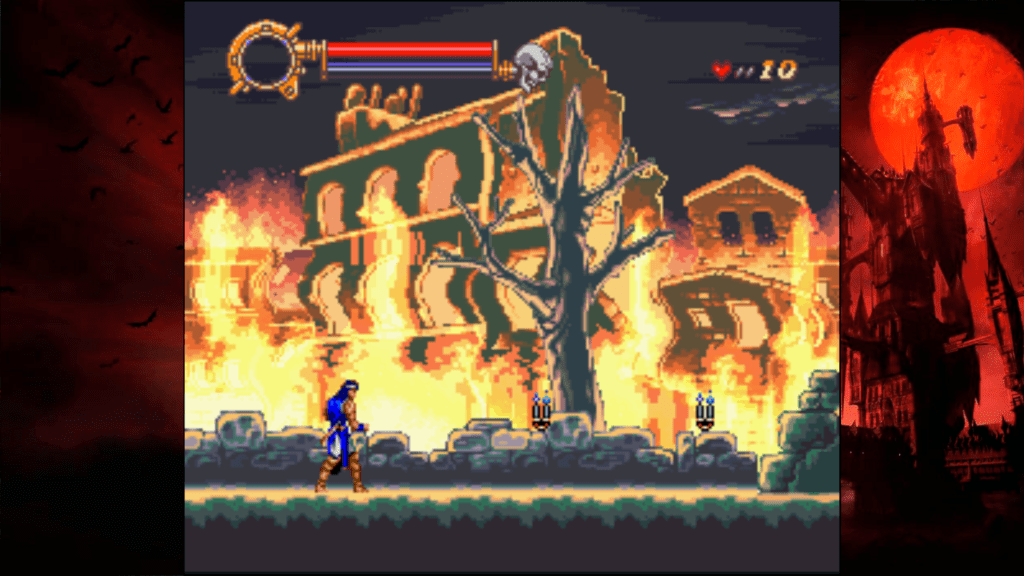
However, popping with color might look great, but there were times where I would have liked a little less. One of the elements that really struck me about the first Castlevania was the Gothic style. This time around, Dracula’s castle in Dracula X feels much less like it emerged from Bram Stoker’s pages. Sometimes the backdrops were almost cartoony in nature, which just killed the mood. I would have liked some things to be a bit more grungy I guess, but overall the look is top notch.
Richter and Simon play almost identically, both armed with their trusty whip and a series of side items. A few quality of life changes have been implemented. You can now jump onto stairs, which may seem like a minor thing, but it’s so useful! Your whip now has a small hitbox behind you before you lash out, giving you a few more options. Finally, Richter can unleash powerful screen-clearing “Item Crashes.” These can range from hurling bouncy crosses that fill the screen to making it rain holy water. All of them look amazing and help you power your way though some of the harder screens.
And, make no mistake, this game has some difficult sections. The focused level design allows for a more catered challenge, and of all of the games I’ve played for these reviews, I’d probably say this is the fairest of all of them. It still provides a hefty Castlevania challenge, with each screen being a gauntlet of creatures and platforms that requires the same patience and timing as before. However, there are significantly less unfair moments. The speed of a lot of the flying enemies have been reduced and the game relies on them less and less during pitfall sections. Instead, bats and medusas are used during vertical platforming challenges. Instead of getting hit and instantly dying, you’ll simply fall down a section of the room and have to try again. It’s still frustrating, but it’s a lot more manageable.
Dracula X returns to a linear level format, however it does twist here and there. There are series of branching paths that allow you to experience different areas of Dracula’s castle and even skip certain bosses. There’s a real balance struck between the linear structure and the sense of exploration that Simon’s Quest tried and failed to create. If you want to simply play through the game, then that’s easy to do: just follow the path in front of you. However, if you want to get the true ending, then you’re going to have to explore a little.
Now, to be clear, I loved exploring the castle, but one element of this true ending is really a hassle. A few stages in Dracula X have alternate exits and locked doors. To get the secret ending, you have to find Richter’s girlfriend Annet and her sister Maria. To do that, you have to find a hidden key at the end of one level, then carry that key to two locked doors in other levels to free Dracula’s prisoners.

This would be totally fine if it wasn’t really easy to miss the key. At the end of Level 4, you come across a long room filled with separated platforms. The goal is simple: cross this incredibly long room without falling. The key is hidden at the end of the gauntlet. However, the platforms are spaced just far enough apart so that any hit you take will certainly knock you off. Unlike the rest of the game, falling here doesn’t result in losing a life. It moves you on to the next stage.
This means if you take one bad hit, then you can kiss goodbye the good ending of the game. The alternative is to replay the entire stage and perfect that one single screen. It’s a small complaint, but I wound up having to play the stage three or four times. This was only because I knew about the hidden ending. If you didn’t and just fell through, then you wouldn’t think anything of it. Hiding a true ending is fine, and doing so should be a challenge. However, it should be an opt-in challenge; you should learn about it early, and therefore have the ability to make the decision to hunt it down. As it is, it sneaks up on you, and it’s easy to miss. I think a little more signposting in regards to that one room would have been nice.
I really don’t have many bad things to say about Dracula X. Ultimately, I think the graphics were great, although a little off-theme for the series. The return to the series’ roots in terms of gameplay was welcome, and the difficulty was just right. I guess my only other issue is that Richter doesn’t really stand out. Simon and Richter play nearly identically, with Richter only having his Item Crashes to differentiate the two. To relate this back to Smash Bros., it makes sense why Richter is just an echo fighter. There’s really nothing about him that stands out. I like his blue jacket, I guess.
Graphics – 8/10
Music – 9/10
Gameplay – 9/10
Fun rating – 8/10
Overall, 8.5. This game winds up being the most accessible out of the early Castlevania games I played. The spritework is second to none, and while the game pulls no punches, it resorts to fewer cheap shots than the first.
Peace and Serenity Have Been Restored
Castlevania games are really fun when they’re actually Castlevania games. After Dracula X, the series shifts gears to a Metroidvania approach. Those games are great, but it’s important not to overlook the series’ roots. Especially given those games are still incredibly fun. If you have the patience for it, I highly recommend hunting down a copy of the original Castlevania. The game oozes classic horror and feels amazing to whip your way through.
Like a lot of harder games, these games probably aren’t for everyone, but those wanting an old-school challenge will have a great time. I know I did. There are so many Castlevania games out there, and so many of them are amazing.
Not Simon’s Quest though. Just pretend that one isn’t there. I wish I did.
Luke spent too many years getting a degree in Media Studies that he needs to justify, so now he’s here. He spends most of his time with charming cutesy indie platformers, overly cheesy video novels, or with his collection of ancient games that time has forgotten. If there’s one thing he strives to do above all else, it’s to complete games to 100%, although most of the time he gets halfway there and gets distracted by a shiny new title.
When he’s not playing video games, you can find him spending way too much time writing Dungeons & Dragons sessions, making podcasts, or failing to create academic readings of children's cartoons. He’s also Scottish, which he only mentions because Americans spell a lot of words wrong and his way is totally the right one.


